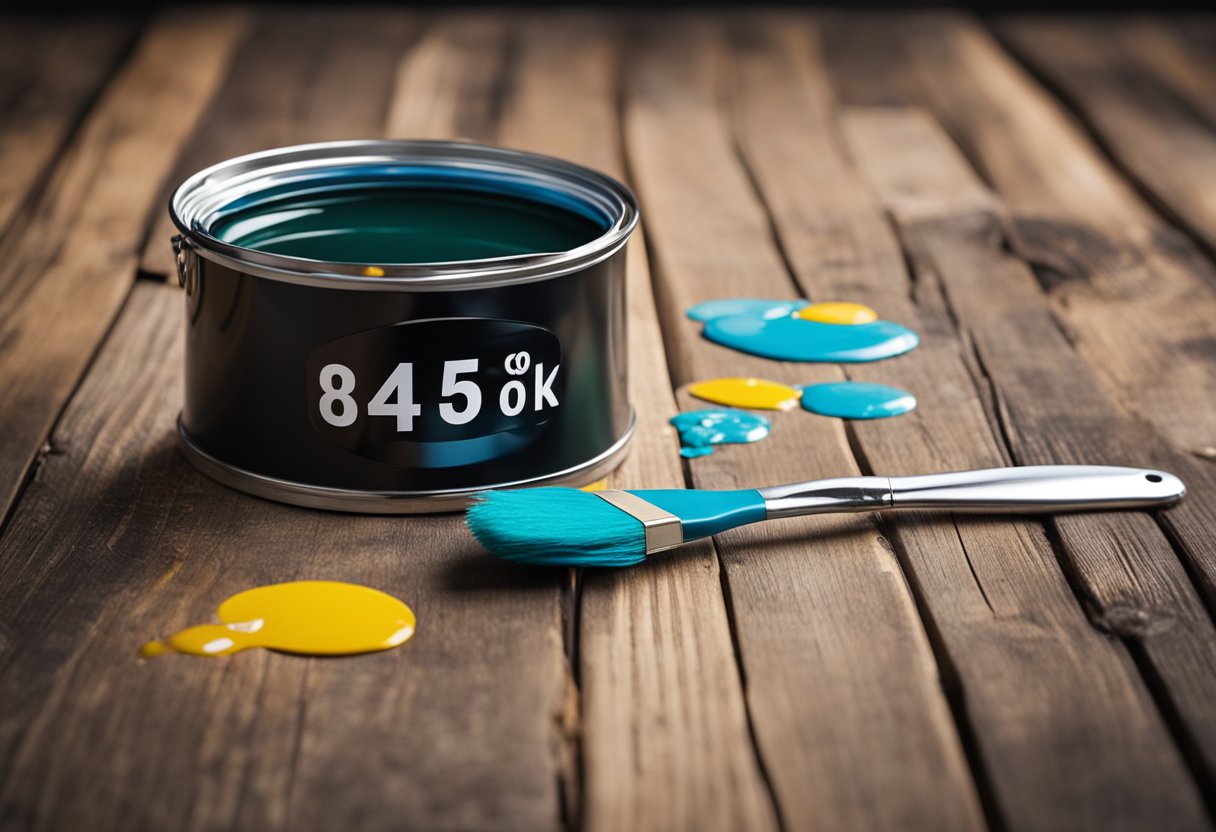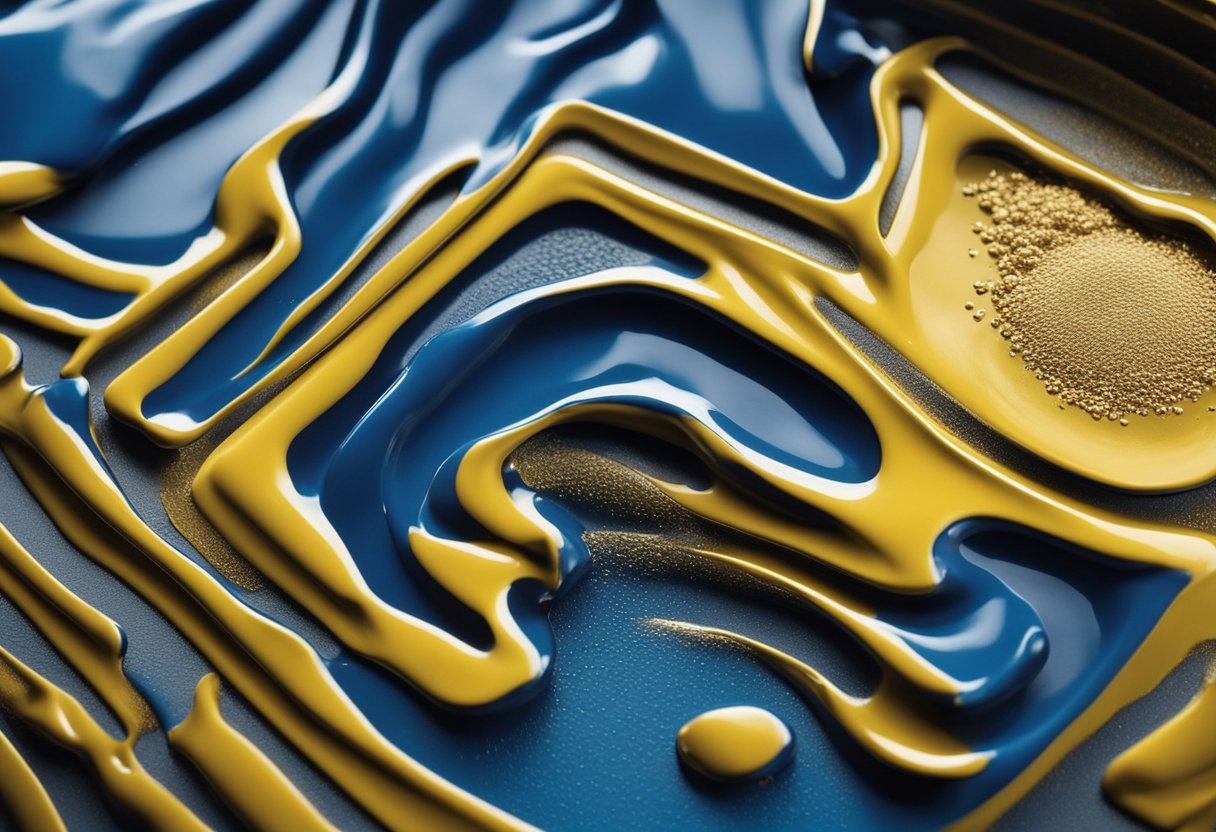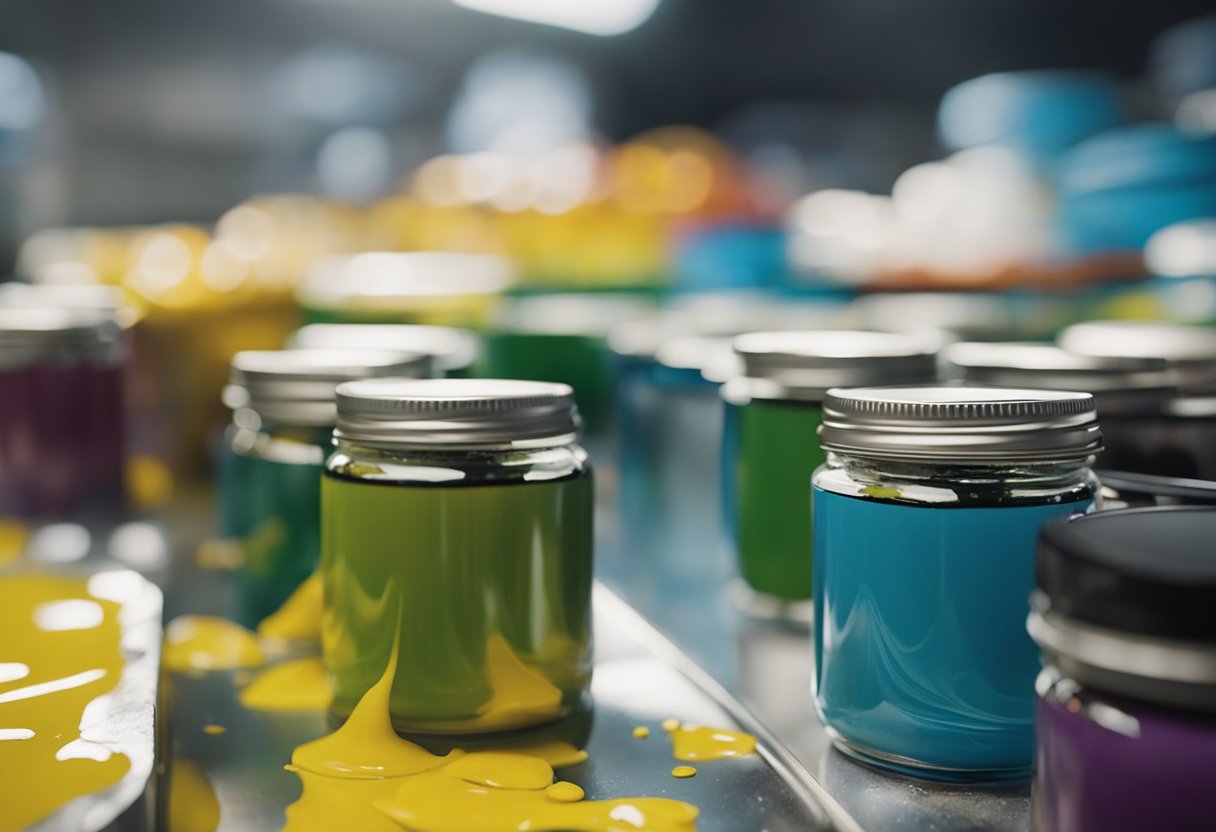Enamel paint is a popular choice for painting surfaces like wood, metal, and ceramics, as it offers a durable and glossy finish. However, one of the most common questions about enamel paint is how long it takes to dry. The drying time can vary depending on several factors, such as the type of enamel paint, the surface being painted, and the application method used.
Understanding the drying process of enamel paint is essential to achieve the best results. Enamel paint typically dries in two stages: the initial drying stage, where the paint becomes tacky to the touch, and the curing stage, where the paint hardens and reaches its maximum durability, protection, and adhesion. The curing process can take several days or even weeks, depending on the type of enamel paint and the environmental conditions.
Key Takeaways
- Enamel paint dries in two stages: the initial drying stage and the curing stage.
- The drying time of enamel paint depends on various factors, such as paint type, surface, and application method.
- To speed up the drying process, you can adjust environmental conditions or use additives, but be cautious to avoid potential issues.
Understanding Enamel Paint
https://www.youtube.com/watch?v=Ps4dkMaAzQ8&embed=true
I love working with enamel paint because it gives a glossy and durable finish. Enamel paint is a type of paint that dries to a hard and glossy finish. It is made up of pigment, solvents, and binders that are mixed together to create a smooth and even consistency.
There are two types of enamel paint: oil-based and water-based. Oil-based enamel paint is made with a solvent that evaporates as the paint dries. This type of paint takes around 6 hours to dry between coats and 48 hours to cure (fully dry). On the other hand, water-based enamel paint uses acrylic latex resins as the binder and water as the solvent. It dries much faster than oil-based enamel paint, taking around 2 hours to dry between coats and 8 hours to cure (fully dry).
Enamel paint has a high solids content, which means that it has a high amount of pigment and binders compared to other types of paint. This makes it more durable and resistant to wear and tear. The binders in enamel paint are usually made of acrylic latex resins, which are very strong and durable.
To speed up the drying process of enamel paint, you can add a naphtha-based additive or cobalt to the paint. These additives help to break down the molecules in the paint, allowing oxygen to reach the surface and help the paint to dry faster.
Overall, enamel paint is a great choice for projects that require a durable and glossy finish. It is important to choose the right type of enamel paint for your project and to follow the manufacturer’s instructions for best results.
Preparation Before Painting
https://www.youtube.com/watch?v=1Y0FHunio0Y&embed=true
Before beginning to paint with enamel paint, it is essential to prepare the surface to ensure the best possible adhesion and finish. Proper preparation involves cleaning the surface and removing any loose or flaking paint, dirt, dust, or other debris that may interfere with adhesion.
For wood surfaces, sanding the surface with fine-grit sandpaper can help create a smooth and even surface that will allow the paint to adhere better. Additionally, using a primer can help improve adhesion and ensure a more even finish.
For metal surfaces, it is essential to remove any rust or corrosion and then clean the surface thoroughly to remove any dirt, grease, or oil. Using a primer designed for metal surfaces can help improve adhesion and prevent rust from forming.
For plastic surfaces, it is essential to clean the surface thoroughly and then use a plastic adhesion promoter to improve adhesion.
Regardless of the surface type, it is essential to ensure that the surface is completely dry before painting. Any moisture or dampness can interfere with adhesion and cause the paint to peel or flake.
In addition to preparing the surface, it is also important to prepare the workspace. Dust and debris can settle on wet paint and cause imperfections, so it is essential to work in a clean and dust-free environment. Covering nearby surfaces with plastic or drop cloths can help prevent dust and debris from settling on the wet paint.
Application Methods
https://www.youtube.com/watch?v=ucyw0pcoglU&embed=true
When it comes to applying enamel paint, there are a few methods you can use, including brushing, rolling, and spraying. The method you choose will depend on the surface you are painting and your personal preference.
Brushing is the most common method for applying enamel paint. It is also the easiest method for beginners. When brushing, it is important to use a high-quality brush and to apply thin coats. Thick coats can take longer to dry and may not dry evenly.
Rolling is another method that can be used to apply enamel paint. This method is ideal for large surfaces, such as walls or ceilings. When rolling, it is important to use a high-quality roller and to apply thin coats. Thin coats will dry faster and will be less likely to leave roller marks.
Spraying is a method that can be used to apply enamel paint to large surfaces quickly. This method requires special equipment and should be done in a well-ventilated area. When spraying, it is important to apply thin coats to avoid drips and to ensure even coverage.
No matter which method you choose, it is important to apply thin coats of enamel paint. Thin coats will dry faster and will be less likely to crack or peel. Additionally, applying multiple thin coats will result in a smoother and more even finish.
In conclusion, the application method you choose will depend on your personal preference and the surface you are painting. Regardless of the method you choose, it is important to apply thin coats of enamel paint to ensure even coverage and a smooth finish.
Drying and Curing Process
https://www.youtube.com/watch?v=F4F3aWX788U&embed=true
When it comes to enamel paint, it is important to understand the drying and curing process. The drying time refers to the time it takes for the paint to dry to the touch, while the curing time refers to the time it takes for the paint to fully cure and reach its maximum hardness.
Enamel paint can dry through two processes: evaporation and oxidation. Evaporation is the process by which the solvents in the paint evaporate, leaving behind a dry film. Oxidation is the process by which the paint reacts with oxygen in the air to form a hard film.
The initial drying time for enamel paint can vary depending on the type of enamel paint used, the surface it is applied to, and the environmental conditions. Oil-based enamel paint typically takes around 6 hours to dry to the touch, while water-based enamel paint can dry in as little as 2 hours. However, it is important to note that the curing process takes much longer than the initial drying time.
The curing process for enamel paint can take anywhere from 2 weeks to a month, depending on the type of enamel paint used and the environmental conditions. During this time, the paint becomes increasingly less vulnerable to scratching and other damage as it approaches its maximum hardness.
In summary, understanding the drying and curing process of enamel paint is crucial to achieving a successful paint job. It is important to allow ample time for the paint to fully cure before subjecting it to any wear and tear.
Factors Affecting Drying Time
https://www.youtube.com/watch?v=wbmn-wLpg7s&embed=true
As a professional painter, I know that enamel paint drying time is influenced by several factors that can affect how long it takes for the paint to dry and cure properly. Let me explore each of these factors in more detail:
1. Temperature
Temperature is one of the most important factors affecting the drying time of enamel paint. The ideal temperature range for applying enamel paint is between 50°F to 90°F. If the temperature is too low, the paint will not dry properly and will take much longer than usual. On the other hand, if the temperature is too high, the paint will dry too quickly, which can result in a poor finish.
2. Humidity
Humidity is another important factor that affects the drying time of enamel paint. High humidity levels can slow down the drying process, while low humidity levels can speed it up. It is recommended to paint in a room with a humidity level of around 40-50%.
3. Ventilation and Air Circulation
Proper ventilation and air circulation are crucial for the drying process of enamel paint. Good air circulation helps to reduce the moisture in the air, which can speed up the drying process. It is recommended to use fans or open windows to increase air circulation.
4. Environmental Conditions
The environmental conditions in which the paint is applied can also affect the drying time. If the environment is too humid, it can take longer for the paint to dry. Similarly, if the environment is too dry, the paint can dry too quickly, resulting in a poor finish. It is important to create a balanced environment by using a dehumidifier or by reducing moisture in the air.
In conclusion, the drying time of enamel paint can be affected by several factors, including temperature, humidity, ventilation, air circulation, and environmental conditions. By taking these factors into consideration and creating an optimal environment for painting, you can ensure that your enamel paint dries and cures properly.
Speeding Up the Drying Process
As I mentioned earlier, enamel paint can take a long time to dry, and it can be frustrating to wait for it to finish drying. Fortunately, there are ways to speed up the drying process. Here are a few tips:
Use a Fan
One of the easiest ways to speed up the drying process is to use a fan. A fan will help to circulate the air around the painted surface, which will help the paint dry faster. You can use a regular fan or a box fan, depending on the size of the painted surface.
Apply Heat
Another way to speed up the drying process is to apply heat to the painted surface. You can use a heater or a hairdryer to apply heat to the painted surface. Be careful not to hold the hairdryer too close to the surface, as this can cause the paint to bubble or blister.
Use a Drying Agent
A drying agent, also known as Japan drier, can be added to the paint to speed up the drying process. The drying agent works by increasing the rate at which the solvent evaporates from the paint. Be sure to follow the manufacturer’s instructions when using a drying agent, as using too much can cause the paint to crack.
Use a Thinner Coat
Finally, using a thinner coat of paint can also help to speed up the drying process. Thicker coats of paint take longer to dry because the solvent has a harder time evaporating from the paint. By using a thinner coat of paint, you can help the solvent evaporate faster, which will help the paint dry faster.
By using these tips, you can help to speed up the drying process of enamel paint. However, be sure to follow the manufacturer’s instructions when using any of these methods, as using them incorrectly can cause the paint to crack or blister.
Assessing Paint Dryness
When it comes to assessing the dryness of enamel paint, there are a few methods to consider. One of the most common ways is the indent test. This involves gently pressing your fingernail into the painted surface and checking if it leaves an imprint. If it does, then the paint is not fully dry yet. If there is no imprint, then the paint has dried and cured properly.
Another method is the “second coat” test. If you are applying a second coat of enamel paint, it is important to wait for the first coat to dry completely before applying the second. The recommended recoat time can be found on the paint can label or in the manufacturer’s instructions. Applying a second coat too soon can cause the paint to wrinkle or peel.
It is important to note that the drying time for enamel paint can vary depending on several factors, including the type of paint, the surface it is applied to, and the thickness of the paint layer. As a general rule, oil-based enamel paint takes longer to dry than water-based paint. According to DIY Geeks, oil-based enamel paint takes around 48 hours to cure, while water-based enamel paint takes around 8 hours.
In addition to the above methods, it is also important to follow the manufacturer’s instructions for the specific paint you are using. This includes the recommended drying time and any other specific instructions for the paint application. By following these guidelines, you can ensure that your enamel paint dries properly and provides the desired finish.
Potential Issues and Solutions
When it comes to enamel paint, there are a few potential issues that you may encounter during the drying process. Here are some common problems and solutions that can help you achieve the best results possible.
Cracking and Peeling
One of the most common issues with enamel paint is cracking and peeling. This can happen when the paint is applied too thickly or when it is not allowed to dry properly between coats. To avoid this problem, make sure to apply thin coats of paint and allow each coat to dry completely before applying the next one. It is also important to ensure that the surface is clean and dry before you start painting.
Quality Results
If you want to achieve high-quality results with enamel paint, it is important to use the right tools and techniques. For example, you should use a high-quality brush or spray gun to apply the paint, and you should follow the manufacturer’s instructions carefully. You should also make sure to use the right type of enamel paint for your project, whether it is oil-based or water-based.
Maximum Durability
Enamel paint is known for its durability, but you can maximize its lifespan by taking a few extra steps. For example, you should make sure to apply multiple thin coats of paint rather than one thick coat, as this will help the paint adhere better and last longer. You should also make sure to allow each coat to dry completely before applying the next one, as this will help prevent cracking and peeling.
Testors Enamel Paint
Testors enamel paint is a popular choice for hobbyists and model builders, but it can also be used for a variety of other projects. To get the best results with Testors enamel paint, it is important to follow the manufacturer’s instructions carefully. You should also make sure to use the right type of enamel thinner for your project, as this will help the paint dry more quickly and evenly.
Overall, enamel paint is a great choice for a variety of projects, but it is important to take the time to prepare properly and follow the right techniques to ensure the best results. With the right tools and techniques, you can achieve a durable, long-lasting finish that will look great for years to come.
Frequently Asked Questions
How long does it take for enamel paint to dry on wood?
The drying time for enamel paint on wood can vary depending on the thickness of the paint layer, humidity levels, and temperature. Typically, enamel paint on wood surfaces takes around 8 to 24 hours to dry. Keep in mind that the exact drying time may differ depending on the brand of paint used.
How long does it take for enamel paint to dry on metal?
Enamel paint on metal surfaces typically dries within 6 to 8 hours. However, the drying time can vary depending on factors such as the thickness of the paint layer, humidity levels, and temperature. It is important to check the manufacturer’s instructions for specific drying times.
How can I speed up the drying of enamel paint?
There are a few ways to speed up the drying time of enamel paint. One way is to increase the amount of available oxygen during the curing process. This can be done by using a fan or opening windows and doors to increase air circulation. Another way is to use a drying accelerator or a paint thinner. However, it is important to follow the manufacturer’s instructions when using these products.
How long does enamel spray paint take to dry?
Enamel spray paint typically takes around 24 hours to dry. However, the exact drying time can vary depending on factors such as the thickness of the paint layer, humidity levels, and temperature. It is important to check the manufacturer’s instructions for specific drying times.
How long does it take for high gloss enamel paint to dry?
High gloss enamel paint typically takes longer to dry than other types of enamel paint. It can take up to 24 hours for the paint to dry to the touch, and up to 7 days for the paint to fully cure. The exact drying time may differ depending on the brand of paint used.
How do you know if enamel paint is cured?
Enamel paint is fully cured when it has reached its maximum hardness and durability. This process can take up to 30 days, depending on the type of enamel paint used and the environmental conditions. A good way to test if the paint is cured is to press your fingernail gently into the surface. If the paint does not leave a mark, it is fully cured.

Hi, I’m Sal Muller of Tooltrip.com. My DIY experience led me to understand essential power tools for home projects. Tooltrip.com guides enthusiasts and professionals in choosing right tools for any job. I provide concise top tool reviews for easier, efficient DIY.






